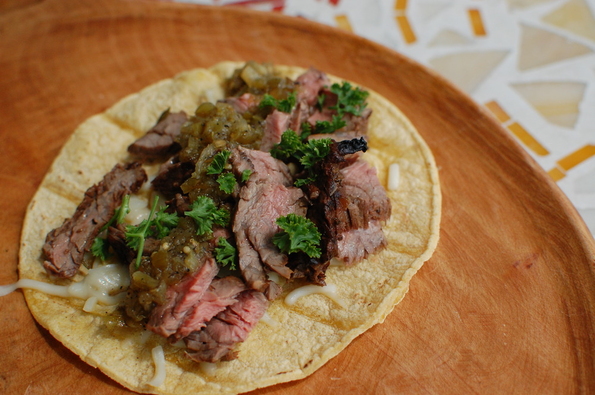I was having lunch the other day with a friend of mine, and we were trying to figure out what we should make for an upcoming barbeque. We wanted to move away from the standard burgers and dogs into something a little more interesting. He first suggested bone-in filets, which are always great, but I always feel like I can’t get quite the heat needed for a hearty, steakhouse char on my home grill. That’s not a problem for a lot of cuts of meat, but when it comes to filets, I want all the flavor I can get, and a nice sear alongside the bone is a big part of that.
I threw out flank steak as an alternative, served either as tacos or on top (or alongside) a Greek salad. His eyes looked at my quizzically — “isn’t that one of the inferior cuts of beef?”.
Flank steak, prepared and served like a normal steak, can be a chewy, tough affair. Long, tough fibers and generous marbling make for lots and lots of chewing if the cut isn’t handled the right way. However, those long fibers, and particularly, the beautiful marbling, create one of the most flavorful and delicious cuts of beef if they are marinated, cooked, and, most importantly, cut, the right way. Combined with a nice salad or fresh corn tortillas, flank steak is the perfect summer steak, and one of my favorite ways to cook beef at home. Of course, this is no secret to anyone who has enjoyed a steak taco hot off the grill at a taqueria — carne asada is simply marinated skirt steak (very similar to flank steak) grilled quickly and chopped up.
Yesterday I came home about an hour before I wanted to serve dinner with a 1.5lb piece of skirt steak in hand. The marinade is key, and I hoped that I could get good flavor in such a short time. Working off a mental list of my favorite things in a skirt steak marinade, I combined chopped fresh rosemary, chopped fresh garlic, soy sauce, lime juice, fresh black pepper, olive oil, and salt in a ziplock bag. I mixed it all up, added the steak, and pressed all of the air out of the bag. Since the meat was cold, I left the bag out on the counter for 45 minutes to bring it to optimum grilling temperature (room temperature) as well as more quickly infuse the marinade.
I then turned the grill up as high as it would go, and laid the steak across the grates. After roughly 4 minutes, I flipped the strip of delicious meat, and gave it another 4-5 minutes until the poke test felt like the meat was roughly medium-rare. Of course, you could also use a thermometer or even cut into the meat to determine if it’s cooked to your liking — although try to cut as little as possible, as cutting meat hot off the grill will cause juices to run out.
After a 10 minute rest of the cutting board, I cut the meat into strips against the grain. You can tell which way the grain is by looking closely at the surface of the meat and determining which direction the fibers are running. On skirt steak, the fibers run perpendicular to the length of the meat, so your cuts are going to be in the same direction as the long side of the meat. Once the meat is in strips, cut into smaller pieces for tacos or leave in strips for salad, and enjoy! For me, about 1/4 of the strips end up in my stomach right from the cutting board, but your mileage may vary.
